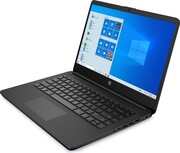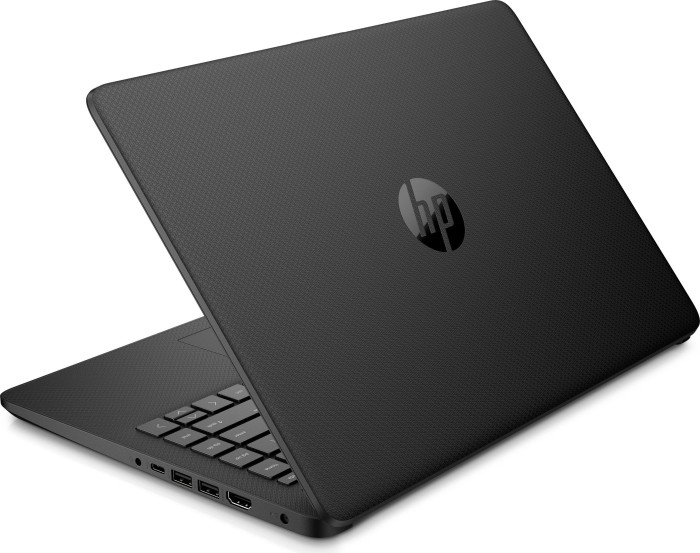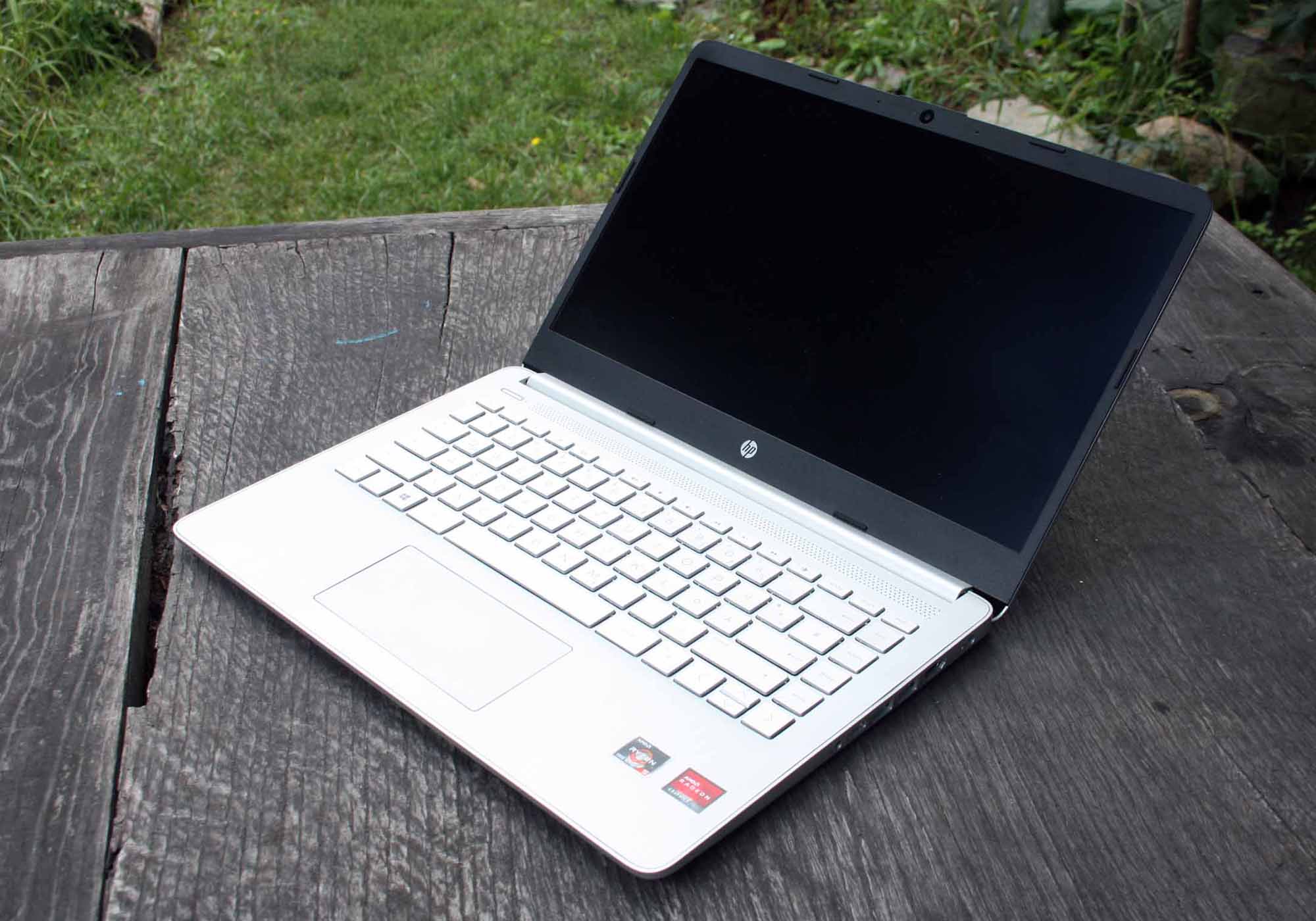HP 14s-fq Series
 Processor: AMD Lucienne (Zen 2, Ryzen 5000) R5 5500U, AMD Lucienne (Zen 2, Ryzen 5000) R7 5700U, AMD Raven Ridge (Ryzen 2000 APU) 3020e
Processor: AMD Lucienne (Zen 2, Ryzen 5000) R5 5500U, AMD Lucienne (Zen 2, Ryzen 5000) R7 5700U, AMD Raven Ridge (Ryzen 2000 APU) 3020eGraphics Adapter: AMD Vega 3, AMD Vega 7, AMD Vega 8
Display: 14.00 inch
Weight: 1.46kg, 1.47kg
Average of 1 scores (from 3 reviews)
HP 14s-fq1357ng
Specifications
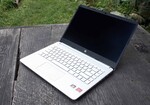 Notebook: HP 14s-fq1357ng
Notebook: HP 14s-fq1357ngProcessor: AMD Lucienne (Zen 2, Ryzen 5000) R5 5500U
Graphics Adapter: AMD Vega 7 512 MB
Display: 14.00 inch, 16:9, 1920 x 1080 pixels
Weight: 1.46kg
Links: HP homepage
Price comparison
Reviews
The slim 14s is a bread & butter model from the manufacturer. It can be equipped with hardware from cheap to expensive. We take a look at a 2021 model with the popular Ryzen 5000 chip. Do we find the strengths of the current AMD generation confirmed here as well? Partly yes, partly no.
HP 14s-fq1083AU
Specifications
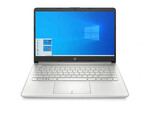 Notebook: HP 14s-fq1083AU
Notebook: HP 14s-fq1083AUProcessor: AMD Lucienne (Zen 2, Ryzen 5000) R7 5700U
Graphics Adapter: AMD Vega 8
Display: 14.00 inch, 16:9, 1920 x 1080 pixels
Weight: 1.47kg
Links: HP homepage
Price comparison
Foreign Reviews
Source: Pemmzchannel
 ID→EN
ID→ENPositive: Powerful processor; high performance; attractive price; premium design; long battery life; compact size; light weight.
Single Review, online available, Long, Date: 06/27/2022
HP 14s-fq0009ns
Specifications
 Notebook: HP 14s-fq0009ns
Notebook: HP 14s-fq0009nsProcessor: AMD Raven Ridge (Ryzen 2000 APU) 3020e
Graphics Adapter: AMD Vega 3
Display: 14.00 inch, 16:9, 1366 x 768 pixels
Weight: 1.46kg
Links: HP homepage
Price comparison
Foreign Reviews
Source: Mi Mundo Gadget
 ES→EN
ES→ENPositive: Elegant design; compact size; good processor; long battery life. Negative: Poor display; eMMC storage instead of SSD.
Single Review, online available, Medium, Date: 07/03/2022
Comment
HP: Founded in 1939, the US company is a major server and printer manufacturer and one of the leading IT companies in the world. Until 2015, the company was called Hewlett-Packard Company. After a split, the computer division was renamed HP Inc.
In 2023, HP had an approximate market share of 22% of global PC sales, making it number 2 after Lenovo.
Modern games should be playable with these graphics cards at low settings and resolutions. Casual gamers may be happy with these cards.
AMD Vega 7: Integrated graphics adapter of the Ryzen APUs based on the Vega architecture with 7 CUs (= 448 shaders) and a clock speed of up to 1,600 MHz.
AMD Vega 8: Integrated graphics card of the Ryzen APUs based on the Vega architecture with 8 CUs (= 512 shaders) and a clock of up to 2.100 MHz.
AMD Vega 3: Integrated graphics card of the Ryzen APUs based on the Vega architecture with 3 CUs (= 192 shaders) and a clock of up to 1200 MHz.
» Further information can be found in our Comparison of Mobile Graphics Cards and the corresponding Benchmark List.
AMD Lucienne (Zen 2, Ryzen 5000):
R5 5500U: A hexa-core APU designed for use in ultra-thin, upper mid-range laptops. The Ryzen features six Zen 2 CPU cores running at 2.1 GHz to 4.0 GHz alongside the Vega 7 graphics adapter (448 unified shaders running at up to 1,800 MHz). One could be forgiven for thinking Ryzen 5 5500U is a renamed Ryzen 5 4500U - which is not the case. Ryzen 5 5500U is most similar to Ryzen 5 4600U, the most noteworthy difference between the two being the faster iGPU model of the former.
R7 5700U: A laptop-grade APU featuring eight SMT-enabled Zen 2 cores running at 1.8 GHz to 4.3 GHz and a Vega series graphics adapter with 8 CUs clocked at up to 1,900 MHz.
AMD Raven Ridge (Ryzen 2000 APU):
3020e: Mobile APU that integrates two Zen cores (without SMT, therefore 2 threads) clocked at 1.2 to 2.6 GHz. The TDP is specified at 6 Watt and therefore the chip can be passively cooled. The integrated Radeon graphics adapter offers 3 CUs at up to 1,000 MHz (Radeon RX Vega 3). The dual channel memory controller supports DDR4-2400. The chip is manufactured on the 14 nm process and officially counted to the 3000 series of mobile processors.
» Further information can be found in our Comparison of Mobile Processsors.
14.00:
14 inch display size represents a middle ground between the small subnotebook formats and the screens of the standard 15 inch laptops.
The reason for the popularity of mid-sized displays is that this size is reasonably easy on the eyes, provides good resolutions with usable detail sizes, yet does not consume too much power and the devices can still be reasonably compact.
In the past, 14-inch devices were very rare, but now they are the standard for laptops after the 15-inchers.
» To find out how fine a display is, see our DPI List.
No weight comment found (one expected)!
76.9%: This rating is not earth-shattering. This rating must actually be seen as average, since there are about as many devices with worse ratings as better ones. A purchase recommendation can only be seen with a lot of goodwill, unless it is about websites that generally rate strictly.
» Further information can be found in our Notebook Purchase Guide.




